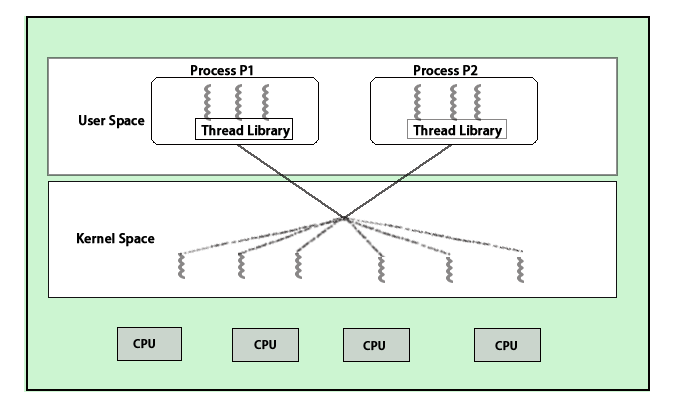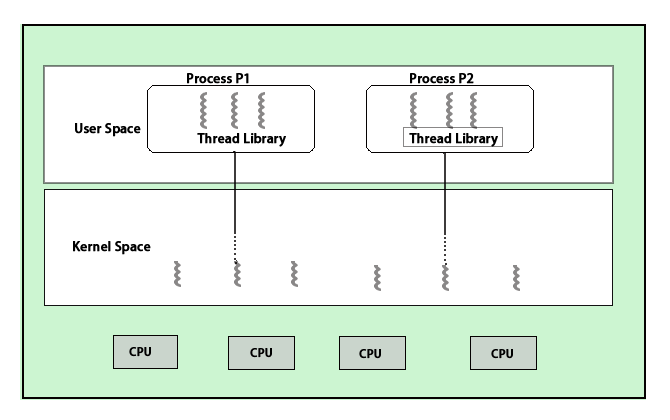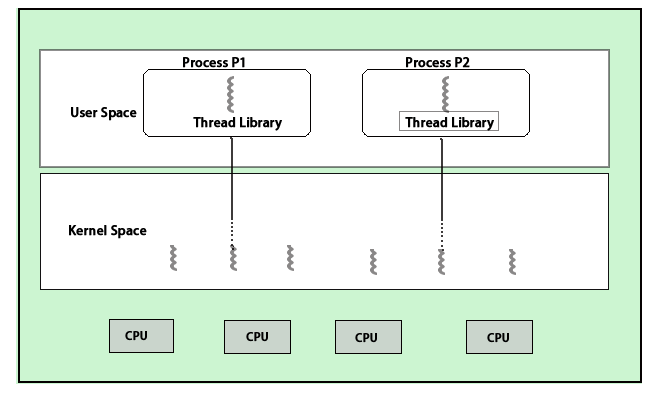Updated March 13, 2023

Introduction to Multithreading
Multithreading is the phenomenon of executing more than a thread in the system, where the execution of these threads can be of two different types, such as Concurrent and Parallel multithread executions. A Thread can be defined as a chunk or unit of a process that can be identified as either a user-level thread or a Kernel-level thread. It is usually used for its essential characteristics like it uses the system resources efficiently, high performance, greatly responsive, and also its parallel execution ability.
Understanding Multithreading
There are two terms that need to be understood :
- Thread: Thread is the independent or basic unit of a process.
- Process: A program that is being executed is called a process; multiple threads exist in a process.
The execution in this is both concurrent and parallel.
- Concurrent Execution: If the processor can switch execution resources between threads in a multithreaded process on a single processor, it is a concurrent execution.
- Parallel Execution: When each thread in the process can run on a separate processor at the same time in the same multithreaded process, then it is said to be a parallel execution.
Types of Thread
- User-level thread: They are created and managed by users. They are used at the application level. There is no involvement of the OS. A good example is when we use threading in programming like in Java, C#, Python, etc., we use user threads.
There are some unique data incorporated in each thread that helps to identify them, such as:
- Program counter: A program counter is responsible for keeping track of instructions and to tell which instruction to execute next.
- Register: System registers are there to keep track of the current working variable of a thread.
- Stack: It contains the history of thread execution.
- Kernel-level Thread: They are implemented and supported by the operating system. They generally take more time to execute than user threads, for example, Window Solaris.
Multithreading Models
These models are of three types
- Many to many
- Many to one
- One to on
Many to many: Any number of user threads can interact with an equal or lesser number of kernel threads.
Many to one: It maps many user-level threads to one Kernel-level thread.
One to one: Relationship between the user-level thread and the kernel-level thread is one to one.
Uses of Multithreading
It is a way to introduce parallelism in the system or program. So, you can use it anywhere you see parallel paths (where two threads are not dependent on the result of one another) to make it fast and easy.
For example:
- Processing of large data where it can be divided into parts and get it done using multiple threads.
- Applications which involve mechanism like validate and save, produce and consume, read and validate are done in multiple threads. Few examples of such applications are online banking, recharges, etc.
- It can be used to make games where different elements are running on different threads.
- In Android, it is used to hit the APIs which are running in the background thread to save the application from stopping.
- In web applications, it is used when you want your app to get asynchronous calls and perform asynchronously.
Advantages of Multithreading
Below are mentioned some of the advantages:
- Economical: It is economical as they share the same processor resources. It takes lesser time to create threads.
- Resource sharing: It allows the threads to share resources like data, memory, files, etc. Therefore, an application can have multiple threads within the same address space.
- Responsiveness: It increases the responsiveness to the user as it allows the program to continue running even if a part of it is performing a lengthy operation or is blocked.
- Scalability: It increases parallelism on multiple CPU machines. It enhances the performance of multi-processor machines.
- It makes the usage of CPU resources better.
Why should we use Multithreading?
We should use this because of the following reasons:
- To increase parallelism
- To make most of the available CPU resources.
- To improve application responsiveness and give better interaction with the user.
Prerequisites
If you know to code and how to write single-threaded programs efficiently, you are ready to learn and apply Multithreading.
Scope of Multithreading
In today’s technical world, software development is not done as it used to be done in historical software.
Nowadays,
- Many-core machines are common, and we can reduce the computational cost by using multiple threads.
- Modern applications fetch information from a variety of sources.
These two factors are simply telling us that information will be available in an asynchronous fashion. So in the near future, what would matter is not multithreading but a way to deal with asynchrony, and asynchrony can only be dealt with multithreading.
Who should learn Multithreading?
People doing coding and developing applications or software or processors should learn this as this is the only way to make use of your CPUs and handle asynchrony.
Career growth
This technique will never die because it has some unique advantages which any other technique cannot perform. Companies are looking for developers who can code in threads to make the most of the resources and reduce the cost. Therefore, it has good career growth and opportunities.
Conclusion
In the computer world, when we talk about parallelism, we talk about multithreading. Implementing it is reasonably effective and straightforward as it makes the work cheaper. Its specialty to deal with asynchrony makes it unique. Therefore, it is in demand, and it is a worthful technology to learn.
Recommended Articles
This has been a guide to What is Multithreading. Here we discuss the types of Multithreading along with the uses, advantages, working and career growth. You can also go through our other suggested articles to learn more –




